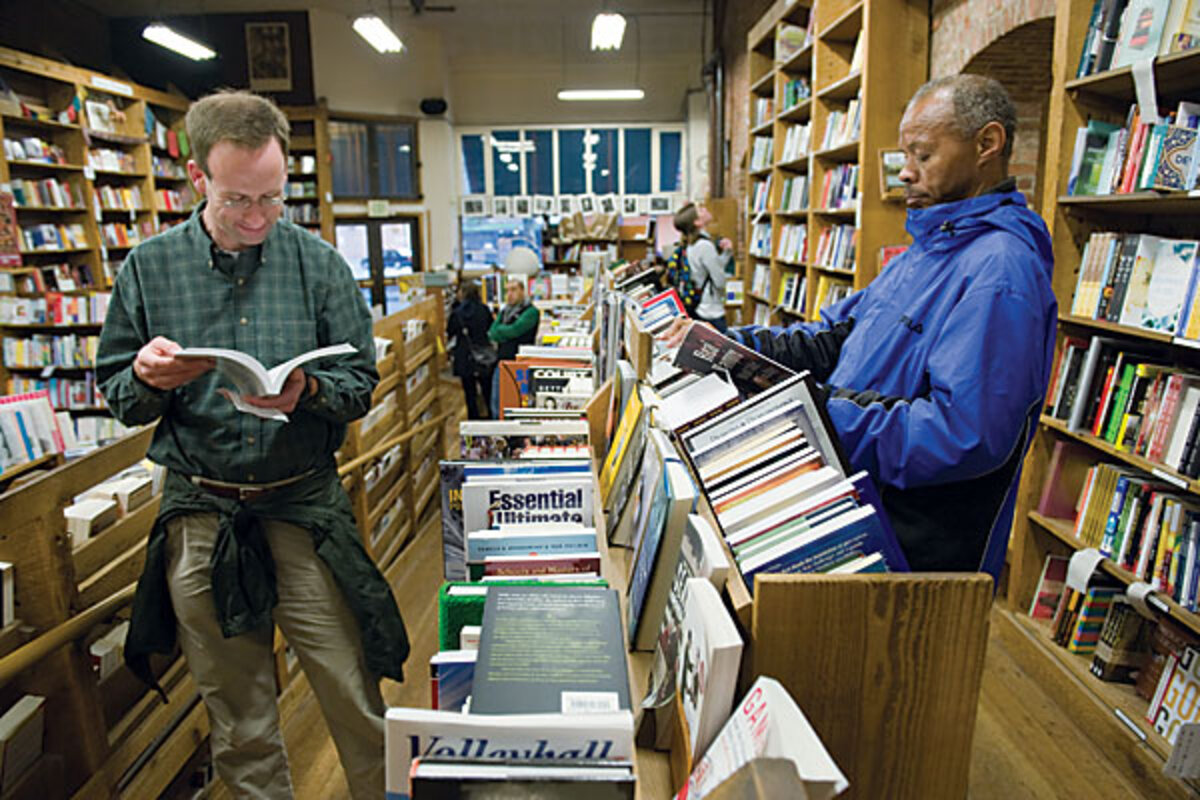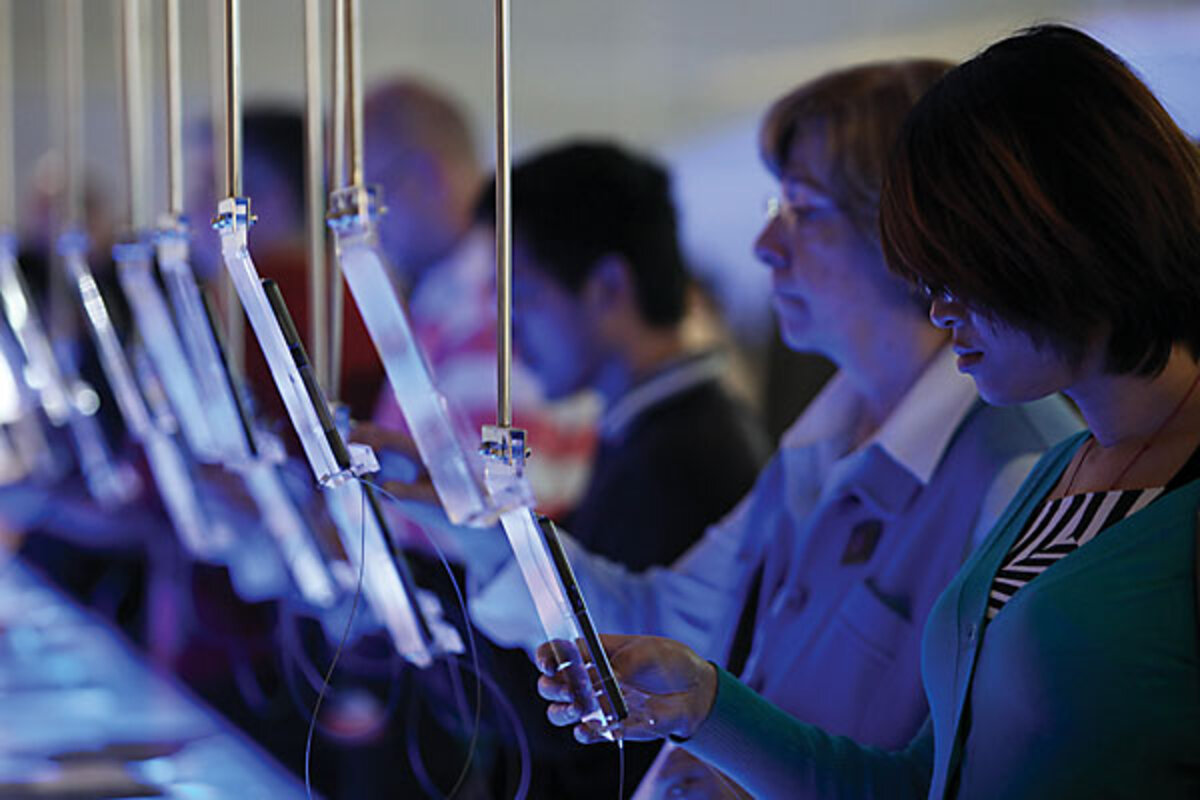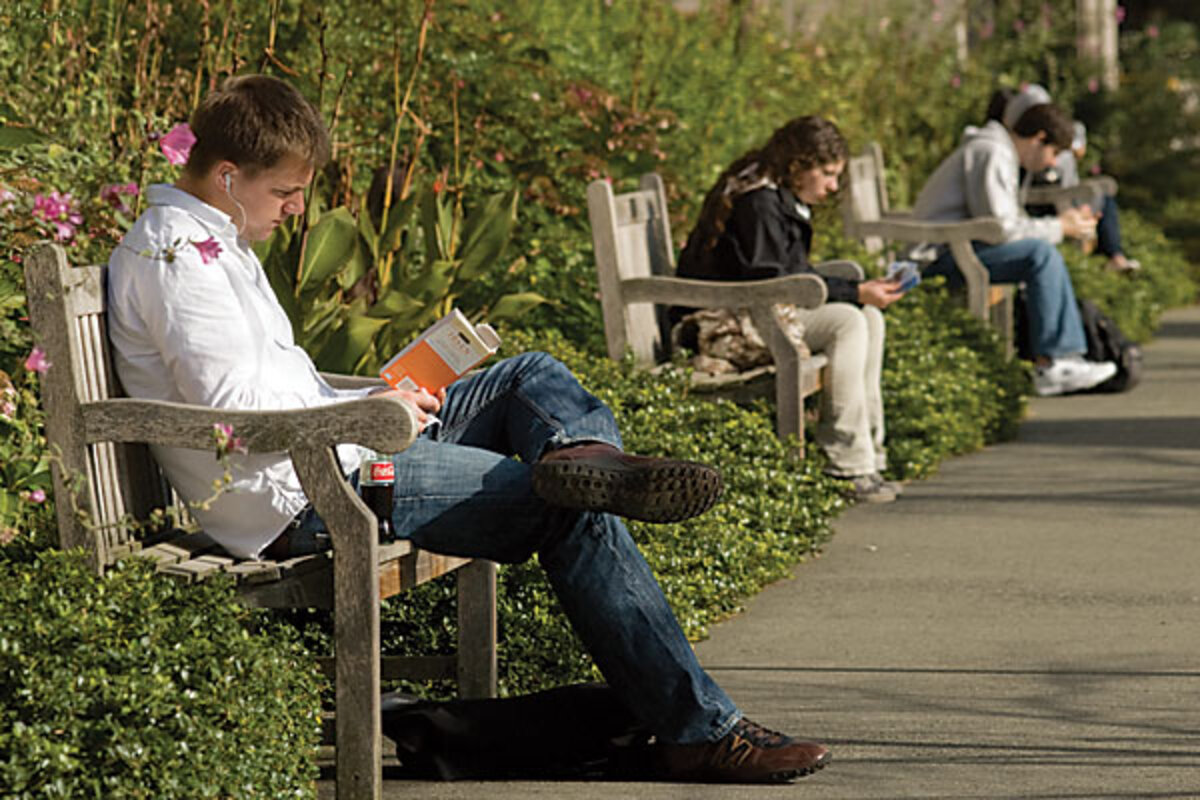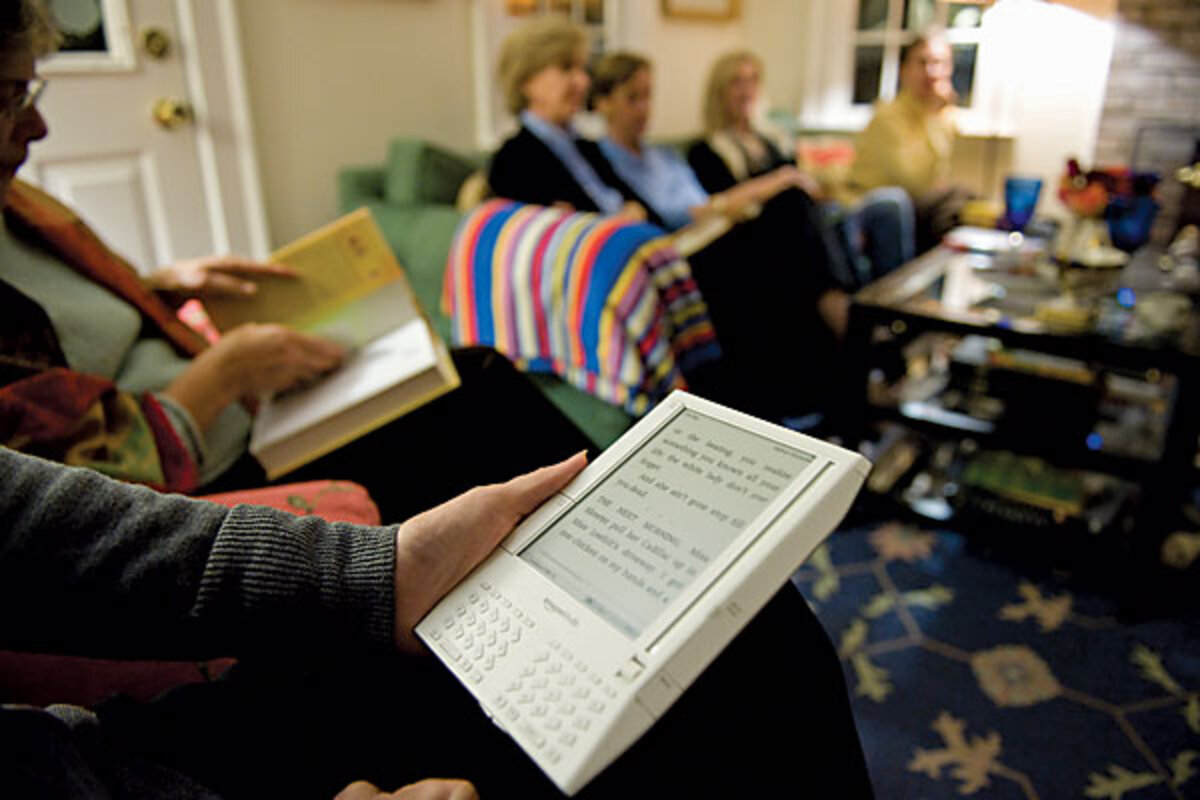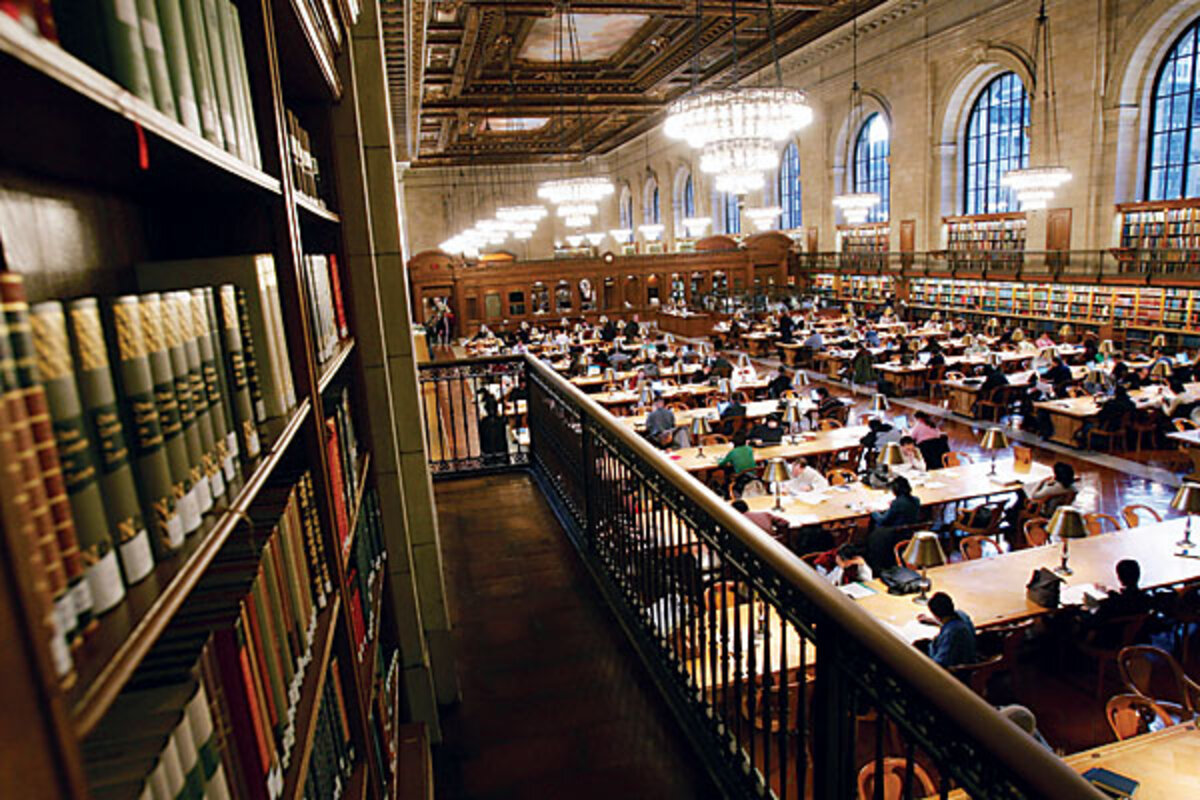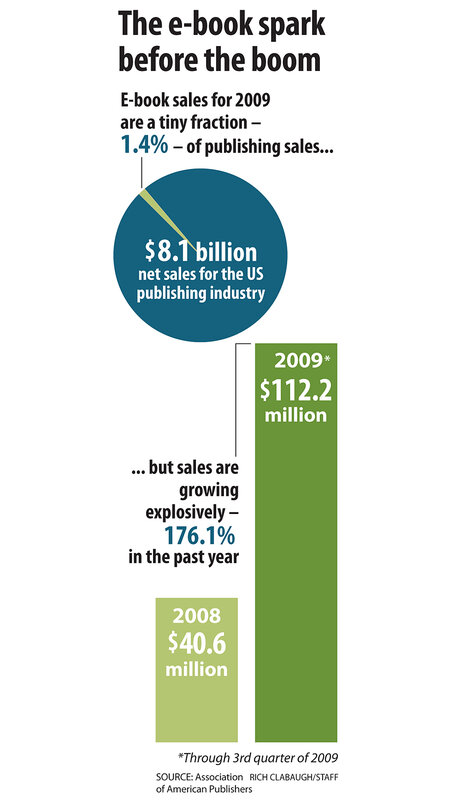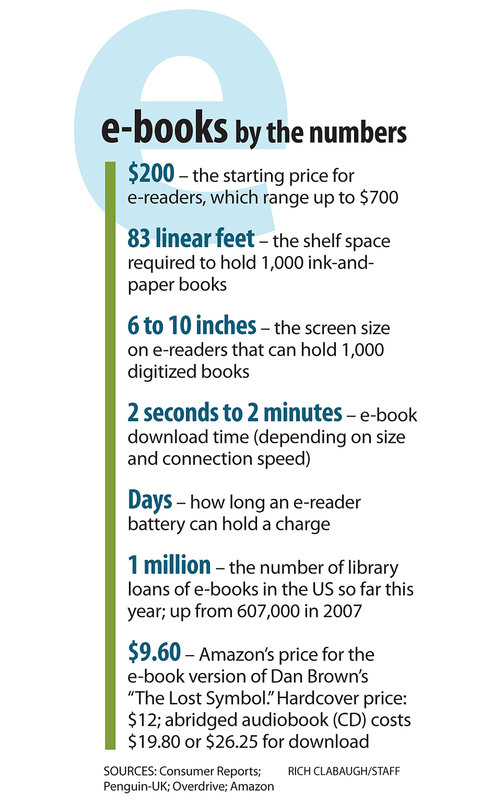The e-book, the e-reader, and the future of reading
Loading...
| New York
Jeremy Manore, an 18-year-old from central New Jersey, subscribes to several magazines and reads books constantly ‚Äď John Steinbeck and F. Scott Fitzgerald are among his favorite writers. When he came home from his elite Massachusetts boarding school for Thanksgiving, Jeremy brought three books to read, his mother, Sandy Manore, says. But he wasn‚Äôt carting heavy volumes in a backpack.
Instead, he‚Äôd checked out a Kindle ‚Äď a wireless reading device ‚Äď from his school library, and downloaded the books he wanted to read. Jeremy‚Äôs school, in Ashburnham, Mass., is the first in the US to digitize its entire collection. This fall, it began moving its 20,000-volume library aside to make room for a ‚Äúlearning center,‚ÄĚ complete with laptop study stations and a fleet of new e-readers with access to millions of digitized books.
‚Äú[We] were really excited when Cushing went digital,‚ÄĚ Mrs. Manore says. The switch to electronic books increased the breadth and depth of her son‚Äôs reading, she says, because the books available to him are no longer limited by what can fit into Cushing‚Äôs library‚Äôs physical space. ‚ÄúIt gives them access to more literature without having to buy it.‚ÄĚ
Not everyone has been so enthusiastic. Cushing‚Äôs decisive step into the new world of reading has put it on the front lines of a battle between traditionalists, who see the glue-and-paper codex as a fundamental part of the learning experience, and e-reading evangelists, who argue that electronic reading ‚Äď with its promise of limitless reach ‚Äď is the logical next step for the 21st-century student.
‚ÄúWhen I look at books, I see an outdated technology, like scrolls before books,‚ÄĚ Cushing headmaster James Tracy told The Boston Globe in September. He was referring specifically to academic research, although the quote ‚Äď which quickly careened around the blogosphere ‚Äď was heralded by many critics as proof of the beginning of the end of the paper book.
Ink-and-paper lovers flooded the comments section of the Globe‚Äôs website, demanding his dismissal; the Cushing plan was called an Orwellian ‚Äď even Hitlerian ‚Äď form of book burning.
‚ÄúThere is no humanity reading a book on a computer,‚ÄĚ wrote an anonymous commenter on the popular site . ‚ÄúYou have lost the interaction with the page. How sorry I am for all of you who will never know the pleasure of turning the pages of a book.‚ÄĚ
The furor over the digitization of Cushing ‚Äď whose bruised administration refused to speak to the Monitor ‚Äď is a taste of what‚Äôs to come as a new future of reading shapes up. The year 2010 is widely seen as a tipping point when the e-book, once an avant-garde oddity, begins to supplant the hidebound codex. As Mr. Tracy noted, this transition, sweeping in scale, recalls nothing less than the move from stone tablets and scrolls to the bound volume.
Already, the number of electronic texts is expanding exponentially, changing the very way we interact with the written word. Sony sells about 100,000 e-book titles through its online store; Barnes & Noble, a million; Amazon, 360,000. Book Search, an initiative headed by Google, has scanned more than 10 million texts since 2004. The Dostoevsky canon can now be searched the same way you search for the nearest Chinese restaurant.
Meanwhile, as computer technology has improved, so has the e-reader, which is now seen as a salable, desirable accessory. By the beginning of 2010, American consumers will be able to choose from an array of plastic e-readers, including models from Amazon, Barnes & Noble, and Plastic Logic; Apple is expected to introduce a tablet of its own. Forrester Research, a market research firm, recently raised its 2010 forecast for US e-reader sales from 2 million to 3 million units. According to the Codex Group, a firm that analyzes the publishing industry, 13 percent of American adults who’ve purchased at least one book in the past year own an e-reader, or plan to own one within the next year.
‚ÄúThis is the beginning of the moment,‚ÄĚ says Steve Haber, the president of digital reading at Sony Electronics.
E-book sales remain a minuscule part of the publishing industry ‚Äď just 1.4 percent of the total $10.9 billion sales in the first nine months of this year, according to the Association of American Publishers. But, not unlike the way digital music overtook traditional CDs overnight, e-books will probably dominate publishing industry sales within 10 years, estimates Mr. Haber, who helped develop the Sony Reader. ‚ÄúIt‚Äôs been building up for a year or so, but going into the [2009] holiday season, it‚Äôs suddenly mass exposure, multiple players in the market, multiple players rumored to be coming into the market. And that‚Äôs what drives innovation. Every year from now on is going to be a leap ahead.‚ÄĚ
* * *
As the friction over Cushing's move demonstrates, this transition won‚Äôt be painless. Books occupy a different place in American culture from TV or movies. Sacrosanct objects, they are symbols of universal knowledge. The idea that books could eventually become just another electronic commodity ‚Äď like Twitter or Facebook ‚Äď strikes many readers as repugnant.
What about the smell of a used bookstore? How can anyone really curl up with an e-reader ‚Äď or use it safely in the bathtub? Who wants their favorite book to suddenly run out of batteries, or succumb to a computer virus?
But the hyperbolic tone of the debate surrounding e-books threatens to drown out what‚Äôs so incredible ‚Äď so downright promising ‚Äď about reading online. Digitization has the potential to make us better readers ‚Äď we can read more; we can read it faster. The next generation of e-readers, for instance, will all be wired to the Internet, either through a 3G-phone network or a wireless connection. Not only will we be able to download dozens of books on the fly ‚Äď many e-readers can hold more than a thousand texts ‚Äď we will be able to notate texts and share those notations with friends hundreds of miles away.
In this way, e-books have radically altered our very conception of the book. Historically, even clothbound and paper books were practically set in stone. You might have been able to scribble in the margins, but you certainly couldn‚Äôt toy with the appearance of the book, or block out huge portions of text. With a modern e-reader, everything becomes a variable: You can instantly look up a word with e-dictionary software in the e-reader; you can shrink or magnify the text; you can highlight a particularly interesting quotation and ‚Äď using the device like a computer ‚Äď share your thoughts with a friend or fellow student halfway around the globe.
‚ÄúE-reader technology is really changing the way students learn,‚ÄĚ says Sam Blyth, the head of progressive Blyth Academy in Toronto. ‚ÄúWe‚Äôre talking fully wireless, increasingly interactive machines ‚Äď the ability to personalize the educational content of the text. For a student with learning strengths or weaknesses, the e-reader can be adjusted to suit them. That‚Äôs a key issue.‚ÄĚ
This year, Blyth Academy became the first high school in North America to replace all textbooks with Sony Readers. (Cushing was the first to begin digitizing its entire collection.) The program, which is funded by the school ‚Äď with training provided by Sony ‚Äď is ostensibly optional. But students choosing to stick with dead-tree textbooks will be required to pay around $700 for their books. E-studying, therefore, becomes a simple value proposition: Get a Sony Reader free of charge and stop lugging around all those textbooks or fork over a substantial chunk of cash.
‚ÄúThe students like the medium,‚ÄĚ Mr. Blyth says. ‚ÄúThey‚Äôre used to it. They‚Äôre more used to it than reading books. They don‚Äôt read hardcover or softcover books like we do.‚ÄĚ
Blyth estimates that the e-reader program ‚Äď which augments, but does not replace Blyth Academy‚Äôs current library ‚Äď would provide students with at least a million new texts, free of charge.
So why such a painful transition?
‚ÄúWe attach this mysticism and exoticism to the book ‚Äď we hold a paper book like it‚Äôs the only possibility,‚ÄĚ says Christopher Harris, a librarian and the creator of the blog . ‚Äú ‚ÄėOnly the book can hold this power,‚Äô we say. Well, that‚Äôs just not right. You can put a book on an iPod or a Kindle. It‚Äôs the same story isn‚Äôt it? Is there really something mystical about printing a book on pulped paper?‚ÄĚ
Mr. Harris says he does not expect the codex to vanish anytime soon ‚Äď in fact, he recently published a glue-and-paper book of his own. But he says that librarians and publishers have a duty not to run kicking and screaming from the idea of e-books, which are about as inevitable as the MP3 was a decade ago.
‚ÄúWe‚Äôre at the hinge point. As a librarian, I have to go where the information goes,‚ÄĚ Harris says. ‚ÄúYes, there are a couple ways to disagree with e-book readers ‚Äď we can complain about the hardware or the software. But as with any disruptive technology, you‚Äôre either guided forward or you‚Äôre steamrolled. The only way to do it is to jump on the tiger and take control of it.‚ÄĚ
In fact, libraries and academic presses are in the vanguard of the e-book movement. The New York Times recently estimated that 5,400 public libraries now offer e-books; the New York Public Library alone has 18,300 electronic titles. OverDrive, a company that provides e-books to libraries, reports that e-book checkouts have risen nationally from 607,275 in 2007 to more than a million in 2009.
Dan Clancy, the engineering director of , says that as libraries continue to amass e-books ‚Äď and as more books become electronically searchable ‚Äď he expects the quality of scholarship to improve.
Mr. Clancy likens Book Search to the Google search engine. The Internet, he says, has always been a wild frontier of uncollected, uncollated data. It took an engine such as Google to present that data in an understandable way. ‚ÄúIf you‚Äôre able to search all these books at the same time, you‚Äôre going to be able to find information you never knew was there,‚ÄĚ Clancy says.
The implications for scholars, students, and lay readers is hard to overstate. Imagine, Clancy suggests, that a scholar is digging for information to weave into a new paper. In the past, the scholar would spend hours running circles through the stacks of the university library, perhaps emerging with three texts. The perspectives, angles, and arguments offered in the three texts would necessarily constrain the breadth of analysis as compared with what that same scholar is able to access today by clicking through millions of texts, searching each volume for phrases or words that correspond to the area of interest.
‚ÄúYou should be spending 10 percent of your time on that same task in the Digital Age,‚ÄĚ leaving the rest of the time for thinking and writing, Clancy says. For educators, this scenario has an obvious appeal ‚Äď electronic books are easy to retrieve and accessible from anywhere.
* * *
On a recent Friday evening, the aisles of the famous Strand bookstore, in lower Manhattan, are alive with chattering, happily tousled patrons. The Strand spills over several levels, including a nook for rare used books; many people are here to browse. To pick up books and turn the worn paper over in their hands. Then there are the dedicated browsers, who mill through each section, viewing each title in context. It‚Äôs a tactile, chaotic experience ‚Äď one unimaginable in the world envisioned by many publishing futurists.
Wave goodbye to a Friday night spent weaving between the stacks at the Strand. Say hello to the ‚Äúvook‚ÄĚ ‚Äď a hybrid of video and text ‚Äď and sprawling interactive books.
Say hello to the e-reader book club, where each member, separated by hundreds of miles, notates a single, mutable, electronic text shared simultaneously and electronically by all members. Say hello to the subscription model currently being tested by Disney, where parents pay $79.95 a year to tap into a treasure-trove of digitized storybooks, full of videos, music, and point-and-click games.
‚ÄúToday, we have a very constrained understanding of reading,‚ÄĚ says Alan Liu, a chairman and professor of English at the University of California, Santa Barbara. ‚ÄúIn the past, reading was a public act ‚Äď there were public readings; newspapers were passed around in a pub. I think we‚Äôre going to start to shed the current notion of the reader as someone who‚Äôs locked into solo interaction with the text.‚ÄĚ The future of online reading, Dr. Liu says, ‚Äúis going to resemble a social-networking environment‚ÄĚ where readers can instantly interact with the publisher, the author, and the text itself.
Sound outlandish? In some ways, the environment described by Liu has already arrived. Facebook hosts several book applications, including one where readers can promote and opine on their favorite books; the majority of authors maintain some sort of Twitter or Facebook presence, the better to chat with their fans. Meanwhile, sites such as SmashWords and Wattpad provide aspiring authors the tools to write, edit, and instantly publish their work.
Just as file-sharing helped democratize the music business ‚Äď ostensibly offering a garage band the same digital stage as a platinum-selling artist ‚Äď a Web-savvy writer can now expect to attain a certain degree of exposure, without the hassle of tracking down an agent, pulling together a proposal, or finding a publisher.
Wattpad counts thousands of writers among its stable of content creators, most of whom traffic in romance, vampire tales, or science fiction. The top authors on the site often attract 400,000 clicks or more to each story; the lines of communication between the reader and the content producer are wide-open. The quality of the prose on Wattpad, it should be said, varies wildly. There is no vetting procedure for authors; you stick a piece up there and it stays up there, unless it breaks some sort of copyright law.
But to Wattpad founder Allen Lau, the openness of the platform is a major selling point.
‚ÄúI hesitate to make any comparison to traditional publishing,‚ÄĚ Mr. Lau says, ‚Äúbecause that implies traditional publishing is actually better. I would say we‚Äôve become an alternative way for authors to generate large audiences in very short amounts of time. We provide a chance to reach out and have a conversation.‚ÄĚ
* * *
Still, many readers worry that the conversation about e-books ‚Äď and the future of reading ‚Äď concentrates on the latest gizmos. But does a battery-powered slab of plastic still grip, inspire, and mold thought in the same ways an old-fashioned book does?
‚ÄúIt‚Äôs not enough to say, ‚ÄėOh, people will read more on an e-reader.‚Äô ‚ÄĚ says Maryanne Wolf, a professor of child development at Tufts University, in Medford, Mass. ‚ÄúMy questions are about how we read.‚ÄĚ
In her book, ‚ÄúProust and the Squid: The Story and Science of the Reading Brain,‚ÄĚ Dr. Wolf argues that the act of reading is evolutionary. Literacy has come to humans slowly, she writes, filtered in trickles or floods from one generation to the next. One of the heroes of her book is Marcel Proust, the 19th-century French novelist. Proust saw reading as an inherently solitary, immersive act; he believed the best books allowed readers a chance to exercise their own imagination.
These days, the opportunity for that kind of ‚Äúdeep dive reading‚ÄĚ is vanishing, Wolf says. We certainly consume a larger variety of content: Forrester Research has reported that the average American used the Internet 12 hours a week in 2009, second only to the 13 hours spent in front of a TV. At any given moment, we‚Äôre watching the stock ticker on our BlackBerry, catching up with a distant cousin on Facebook, tracking gossip on Twitter, perusing the news on csmonitor.com, the Huffington Post, or any of a thousand other sites. We are more wired than we have ever been before. But the rapid-fire pace of social media ‚Äď the RSS feeds, the blog posts, the status updates ‚Äď is no substitute for the immersion we find in a great book.
‚ÄúMy concern is that we will develop within the next generation a shorter, less-enriched [brain] circuitry for reading,‚ÄĚ says Wolf. ‚ÄúAnd I don‚Äôt think I‚Äôm ultraconservative. I‚Äôm not saying that we shouldn‚Äôt read online.... I‚Äôm saying that we need to preserve what‚Äôs best about the present reading brain ‚Äď preserve the beautiful function of books in our lives ‚Äď as we move across mediums that will allow us ever greater access to information.‚ÄĚ
Even the most dedicated futurists agree that the adoption of e-reading will follow a slow curve, expanding outward from a cadre of early adopters to the public at large.
‚ÄúI think we‚Äôre in the very early stages of assembling a tool kit that will enable a tremendous amount of experimentation,‚ÄĚ says Mike Shatzkin, CEO of The Idea Logical Company, a consulting firm. ‚ÄúIt will be many years before we figure out what the new book forms will be and what impact they‚Äôll have on the way people think and behave.‚ÄĚ
In the meantime, readers may inhabit a happy middle ground.
‚ÄúThe technology of the book has withstood 500 years for a reason. It‚Äôs a superior, time-tested object,‚ÄĚ observes Dennis Loy Johnson, the publisher of Melville House, a Brooklyn-based press. ‚ÄúI can envision a future where everyone has a Kindle. But I don‚Äôt think that means the eradication of books.‚ÄĚ
Mr. Johnson predicts a ‚Äúlong-term coexistence.‚ÄĚ He says that ‚Äúif people want to be reading newspapers, they‚Äôll use an electronic device. If people want to be reading fiction or investigative journalism, they‚Äôll stay with the book.‚ÄĚ
The ‚Äúeither/or‚ÄĚ fears of the book being overshadowed by the e-reader, says William Powers, a media critic, seems to be engineered by baby boomers who assume that kids will totally eschew the hardbound book for an electronic screen. ‚ÄúThe human brain doesn‚Äôt change in one generation,‚ÄĚ says Mr. Powers, author of the forthcoming ‚ÄúHamlet‚Äôs BlackBerry: A Practical Philosophy for Building a Good Life in the Digital Age.‚ÄĚ ‚ÄúIt‚Äôs not going to happen like that.‚ÄĚ
Not so long ago, Powers bought a Kindle, expecting that the device would be popular with his 10-year-old son. The gift was a bust.
‚ÄúHe said, ‚ÄėDad, this isn‚Äôt as good as a real book,‚Äô ‚ÄĚ Powers laughs. ‚ÄúThis is a kid who‚Äôs wild about screens. We ended up sending the Kindle back.‚ÄĚ
‚Äď Julie Masis contributed to this article.



